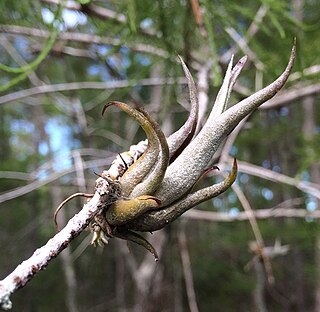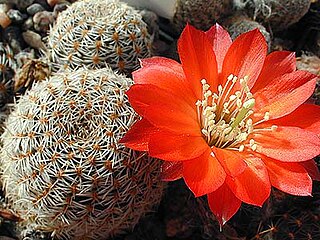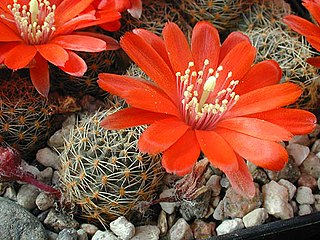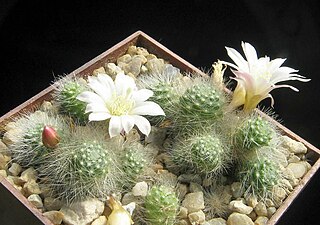
Rebutia is a genus of flowering plants in the family Cactaceae, native to Bolivia and Argentina. They are generally small, colorful cacti, globular in form, which freely produce flowers that are relatively large in relation to the body. They have no distinctive ribs, but do have regularly arranged small tubercles. They are considered fairly easy to grow and they may produce large quantities of seeds that germinate freely around the parent plant.

Cleistocactus is a genus of flowering plants in the cactus family Cactaceae, native to mountainous areas - to 3,000 m (9,843 ft) - of South America. The name comes from the Greek kleistos meaning closed because the flowers hardly open.

Echinocactus is a genus of cacti in the subfamily Cactoideae. The generic name derives from the Ancient Greek ἐχῖνος (echînos), meaning "spiny," and cactus. It and Ferocactus are the two genera of barrel cactus. Members of the genus usually have heavy spination and relatively small flowers. The fruits are copiously woolly, and this is one major distinction between Echinocactus and Ferocactus. Propagation is by seed.

Pachycereus is a genus of large cacti native to Central America and Mexico. They form large shrubs or small trees up to 15 m tall, with stout stems up to 1 m in diameter. Pachycereus comes from the ancient Greek παχύς (pachys) meaning "thick" and the Latin cereus meaning "torch".

In 1984, the International Organization for Succulent Plant Study set up a working party, now called the International Cactaceae Systematics Group, to produce a consensus classification of the cactus family, down to the level of genus. Their classification has been used as the basis for systems published since the mid-1990s. Treatments in the 21st century have generally divided the family into around 125–130 genera and 1,400–1,500 species, which are then arranged in a number of tribes and subfamilies. However, subsequent molecular phylogenetic studies have shown that a very high proportion of the higher taxa are not monophyletic, i.e. they do not contain all of the descendants of a common ancestor. As of August 2023, the internal classification of the family Cactaceae remained uncertain and subject to change. A classification incorporating many of the insights from the molecular studies was produced by Nyffeler and Eggli in 2010.

Pilosocereus is a genus of cactus native to the Neotropics. Tree cactus is a common name for Pilosocereus species. The genera Caerulocereus and Pseudopilocereus are synonyms of this genus.

Aylostera, is a genus of cactus, native to central Bolivia and north western Argentina.

Weingartia is a genus in the family Cactaceae, with species native to Bolivia and Argentina. Molecular phylogenetic evidence suggests that it may be distinct from Rebutia. It is treated as a synonym of that genus by Plants of the World Online as of September 2023, but recognized as an alternative generic name in the third edition of the CITES Cactaceae Checklist. It may also be treated as Rebutia subg. Weingartia.

Opuntia galapageia is a species of cactus. It is endemic to the Galápagos Islands, part of Ecuador. Forms occurring on different islands have been treated as separate species and subtaxa of these species. Opuntia echios, Opuntia helleri, Opuntia insularis, Opuntia megasperma, Opuntia myriacantha and Opuntia saxicola are now sunk within O. galapageia.

Kadenicarpus pseudomacrochele, synonym Turbinicarpus pseudomacrochele, is a species of plant in the family Cactaceae.

Tillandsia paucifolia, the potbelly airplant, is a species of bromeliad in the genus Tillandsia. This species is native to Central America, central and southern Mexico, Venezuela, Colombia, the West Indies, and Florida.

Aylostera albopectinata is a species of Aylostera from Bolivia.
Nicola Mosti is an Italian professional footballer who plays as an attacking midfielder for Serie C Group B club Virtus Entella on loan from Modena.

Cephalomanes atrovirens is a species of fern in the family Hymenophyllaceae. The genus Cephalomanes is accepted in the Pteridophyte Phylogeny Group classification of 2016, but not by some other sources. As of October 2019, Plants of the World Online sank the genus into a broadly defined Trichomanes, while treating the subtaxa of this species as the separate species Trichomanes acrosorum, Trichomanes atrovirens, Trichomanes boryanum and Trichomanes kingii.

Echinopsis densispina, is a species of Echinopsis found in Argentina.

Aylostera pulvinosa, synonym Rebutia pulvinosa, is a species of cactus in the genus Aylostera, native to Bolivia. Aylostera albiflora has been treated as Aylostera pulvinosa subsp. albiflora.

Aylostera pygmaea, synonyms including Rebutia pygmaea, is a species of cactus in the genus Aylostera, native to Bolivia and northwest Argentina. It has gained the Royal Horticultural Society's Award of Garden Merit.
Aylostera leucanthema is a species of flowering plant in the family Cactaceae, native to Bolivia. It was first described in 1975 as Rebutia leucanthema.
Aylostera nigricans is a species of flowering plant in the family Cactaceae, native to northwest Argentina. It was first described in 1940 as Lobivia nigricans.

Aylostera albiflora, synonym Rebutia albiflora, is a species of flowering plant in the family Cactaceae, native to Bolivia. It was first described by Curt Backeberg in 1963 as Rebutia albiflora.
















